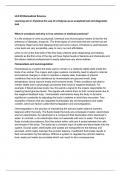Biopsychology Topic Notes
The Nervous System
- Made up of billions of nerve cells working together, primary internal communication system.
Gather, transform and respond to environmental information and ensure synchronisation of
functions of cells
- The Central Nervous System CNS:
Regulation of physiological processes and control of behaviour
THE BRAIN: centre of all conscious behaviour
1) Cerebral cortex, highly developed in humans and what distinguishes our higher mental
functions from those of animals. Largest area and divided into four lobes
Frontal lobe: thought and production of speech
Parietal lobe: processing somatosensory information from the body e.g touch, pain
Temporal lobe: processing auditory information
Occipital lobe: processing visual images
2) Cerebellum
3) Diencephalon
4) Brain Stem
TWO HEMISPHERES: left and right, each specialised for particular behaviour and
communicate with each other through the bridge corpus callosum
THE SPINAL CORD: extension of the brain
Function:
Long bundle of nerve cells.
Carry messages TO and FROM the body to the brain, responsible for fast reflexes
RELAYS messages between the brain and the body
CONNECTED to parts of the body by PAIRS of spinal nerves which connect with specific
muscles and glands
Contains CIRCUIT OF NERVE CELLS that enable us to perform reflexes without the
involvement of the brain
IF DAMAGED: areas supplied by spinal nerves below the damaged site will cut off from the
brain and stop functioning.
- The Peripheral Nervous System PNS:
Send information via millions of neurons TO the CNS from the environment, relay messages
FROM the CNS to the gland and muscles
THE SOMATIC NERVOUS SYSTEM:
Made up of 12 pairs of cranial nerves, emerge directly from the brain, 31 pairs of spinal
nerves, emerge directly from the spinal cord. Have both sensory neurons and motor neurons
Sensory neurons relay messages to the CNS and motor neurons relay information from the
CNS to other areas of the body
SNS controls voluntary muscle movement and receives information from sensory receptors,
also involved in reflex actions without the involvement of the CNS
THE AUTONOMIC NERVOUS SYSTEM
Responsible for involuntary movements, communicates information TO and FROM our
organs
Two branches: regulate the same organs but have opposite effects because of
neurotransmitters associated with each division.
1) The sympathetic nervous system
, Involved in responses that help deal with emergences, fight or flight, increasing heart
rate etc.
Neurons travel from the SNS to every organ and gland, prepares the body for rapid
action when induvial is under threat.
2) The parasympathetic nervous system
Relaxes the individual once the emergency has passed restoring body back to normal
functioning.
Slows heart rate and blood pressure down, digestion begins again. “rest and digest
system”
Neurons and Synaptic Transmission
- Neuron: nerve cells, basic building blocks of the nervous system. Process and transmit
electrical and chemical signals.
- Synaptic transmission: refers to the process by which neighbouring nerve cells communicate
messages to one another across the synapse, gap which separated nerve cells
- Neurotransmitter: brain chemicals which pass across the synaptic gap from neuron to
neuron, either excitatory or inhibitory
- Excitation: occurs when a neurotransmitter increases the positive charge of the postsynaptic
neuron. Increases likelihood that the neuron will fire
- Inhibition: occurs when a neurotransmitter increases the negative charge of the postsynaptic
neuron. Decreases the likelihood that the neuron will fire.
- Structure of a neuron:
Neurons vary I size from less than a millimetre to up to a metre long, all have same basic
structure.
Consist of cell body, dendrites, and an axon
Cell body: contains nucleus which contains genetic material of the cell
Dendrites: branch out from the cell body, receiving signals from nearby nerve cells, carry
nerve impulses from neighbouring neurons towards the cell body
Axon: thing body of the neuron, carries impulses away from the cell body down the length of
the neuron. Covered by fatty insulating material MYELIN SHEATH
Myelin sheath: protects the axon and speeds up electrical transmission of the impulse.
Nodes of Ranvier: gaps in myelin sheath that speed up transmission of the impulse by
forcing it to ‘jump’ across the gaps along the axon
Terminal buttons: located at the end of the axon and communicate with the next nerves
across the synapse, signals within the neuron are communicated electrically but messages
between neurons are communicated biochemically at the synapse.
- Different Types and Structures of neurons:
, Sensory Neuron
Carry nerve impulses from the sensory receptors to the spinal cord and brain, in PNS
Found in different locations e.g. ears, eyes tongue
Convert information from these sensor receptors into neural impulses, when they reach the
brain they are translated into sensations e.g. visual input so the organism can react
appropriately
Not all sensory information travels as far as the brain, some terminate in the spinal cord,
allows reflex actions to occur quickly
SHORT AXONS and LENGHTY DENDRITES
Motor Neuron
Refer to neurons located in the CNS, project their axons outside the CNS and directly control
muscles
Form synapses with muscles and control their contractions. When stimulated, release
neurotransmitters that bind to receptors on the muscle and triggers a response which leads
to muscle movement.
When axon of a motor neuron fires, the muscle which it forms synapse with, contracts.
strength depends on the rate of firing of axons
Muscle relaxation is caused b inhibition of the motor neuron.
LONG AXONS and SHORT DENDRITES











